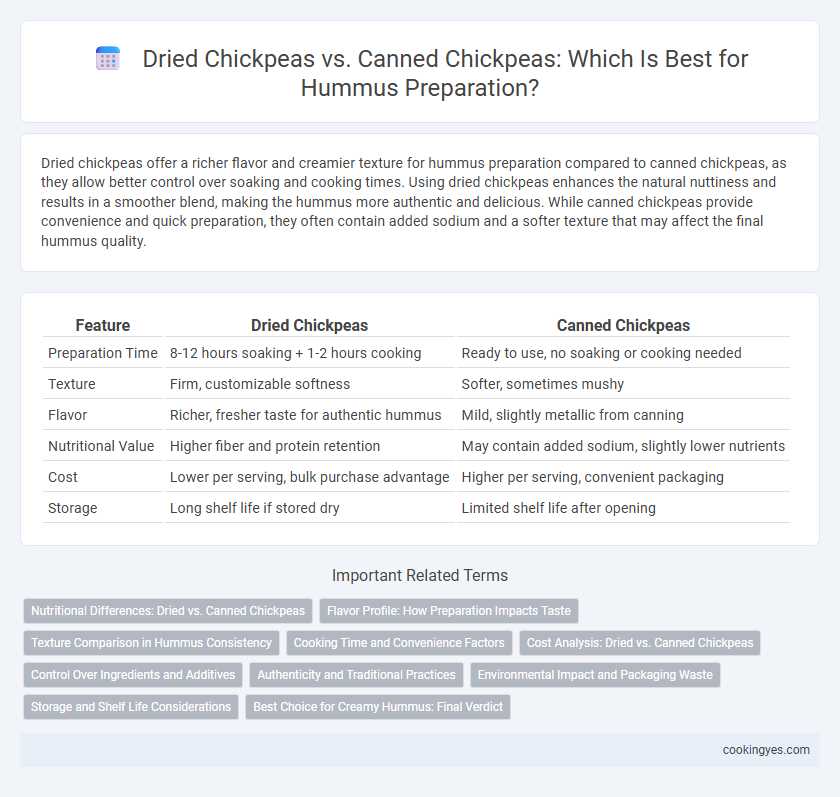Dried chickpeas offer a richer flavor and creamier texture for hummus preparation compared to canned chickpeas, as they allow better control over soaking and cooking times. Using dried chickpeas enhances the natural nuttiness and results in a smoother blend, making the hummus more authentic and delicious. While canned chickpeas provide convenience and quick preparation, they often contain added sodium and a softer texture that may affect the final hummus quality.
Table of Comparison
| Feature | Dried Chickpeas | Canned Chickpeas |
|---|---|---|
| Preparation Time | 8-12 hours soaking + 1-2 hours cooking | Ready to use, no soaking or cooking needed |
| Texture | Firm, customizable softness | Softer, sometimes mushy |
| Flavor | Richer, fresher taste for authentic hummus | Mild, slightly metallic from canning |
| Nutritional Value | Higher fiber and protein retention | May contain added sodium, slightly lower nutrients |
| Cost | Lower per serving, bulk purchase advantage | Higher per serving, convenient packaging |
| Storage | Long shelf life if stored dry | Limited shelf life after opening |
Nutritional Differences: Dried vs. Canned Chickpeas
Dried chickpeas retain more nutrients like fiber, protein, and essential minerals compared to canned chickpeas, which often contain added sodium and preservatives. Soaking and cooking dried chickpeas helps preserve their natural vitamin content, especially folate and iron. Choosing dried chickpeas can enhance the nutritional profile of hummus by reducing excess sodium intake and increasing dietary fiber.
Flavor Profile: How Preparation Impacts Taste
Dried chickpeas offer a richer, nuttier flavor in hummus due to slow cooking and soaking processes that enhance their natural taste and texture. Canned chickpeas provide convenience but often result in a milder, less complex flavor as they are precooked and preserved with added salts or preservatives. For authentic, deeply flavored hummus, dried chickpeas are preferred despite longer preparation time.
Texture Comparison in Hummus Consistency
Dried chickpeas provide a firmer, creamier texture in hummus after proper soaking and cooking, allowing for better control over softness and moisture content. Canned chickpeas tend to produce a smoother but sometimes mushier consistency due to their pre-cooked state and added preservatives. For a thicker, more authentic hummus texture, dried chickpeas are preferred despite the longer preparation time.
Cooking Time and Convenience Factors
Dried chickpeas require soaking for 8-12 hours and cooking for 1-2 hours before blending into smooth hummus, offering enhanced flavor and texture compared to canned chickpeas. Canned chickpeas provide immediate convenience with no soaking or extended cooking needed, making them ideal for quick preparation but often result in a slightly softer texture and milder taste. The choice between dried and canned chickpeas balances between superior hummus quality and time-saving convenience depending on preparation priorities.
Cost Analysis: Dried vs. Canned Chickpeas
Dried chickpeas are significantly more cost-effective than canned chickpeas, offering a lower price per serving when purchased in bulk. Although dried chickpeas require soaking and longer cooking times, their reduced cost and customizable texture make them a preferred choice for budget-conscious hummus preparation. Canned chickpeas provide convenience but at a higher price point, often costing two to three times more per equivalent weight compared to dried options.
Control Over Ingredients and Additives
Dried chickpeas offer superior control over ingredients and additives compared to canned chickpeas, allowing the cook to avoid preservatives, sodium, and stabilizers commonly found in canned varieties. Soaking and cooking dried chickpeas from scratch ensures a fresher, more natural flavor profile and the ability to customize texture by adjusting cooking time. This control ultimately enhances the quality and nutritional value of homemade hummus.
Authenticity and Traditional Practices
Dried chickpeas are preferred for authentic hummus preparation due to their superior texture and flavor, which result from traditional soaking and slow cooking methods. These practices enhance the nutty taste and creamy consistency that define classic hummus recipes across Middle Eastern cultures. Canned chickpeas, while convenient, often lack the depth of flavor and subtle texture nuances essential to traditional hummus authenticity.
Environmental Impact and Packaging Waste
Dried chickpeas have a lower environmental impact compared to canned chickpeas due to reduced packaging waste and less energy-intensive processing. Bulk packaging of dried chickpeas minimizes plastic and metal use, decreasing landfill contributions and resource extraction associated with canned goods. Choosing dried chickpeas supports sustainable consumption by reducing carbon emissions linked to can production and transportation.
Storage and Shelf Life Considerations
Dried chickpeas offer extended shelf life, often lasting up to a year when stored in a cool, dry place, making them ideal for long-term storage before hummus preparation. Canned chickpeas, while convenient and ready to use, typically have a shorter shelf life of about 2-5 years unopened and require refrigeration after opening to maintain freshness. Choosing dried chickpeas reduces dependency on preservatives and packaging, supporting more sustainable storage practices for hummus ingredients.
Best Choice for Creamy Hummus: Final Verdict
Dried chickpeas yield the creamiest hummus due to their ability to absorb more water and soften thoroughly during soaking and cooking, resulting in a smoother texture compared to canned chickpeas. Canned chickpeas offer convenience but often contain added sodium and less ideal moisture content, which can compromise creaminess without extra preparation steps. For the best creamy hummus, soaking and cooking dried chickpeas is the preferred method, ensuring optimal texture and flavor development.
Dried Chickpeas vs Canned Chickpeas for hummus preparation Infographic

 cookingyes.com
cookingyes.com